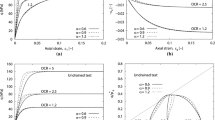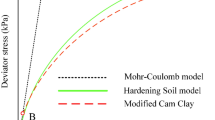Abstract
The extended abstract presents an application of the newly developed hypoplastic model for soft clays. The model is applied to simulation of the well-documented geotechnical failure of a deep excavation occurring at the Nicoll Highway in Singapore. The marine clays occurring at the site are typical example of natural normally consolidated soft soils, which are difficult to characterize and model as they typically suffer from large deformations under loading and their stress-strain behavior is complex. In the new hypoplastic model, anisotropic asymptotic state boundary surface (ASBS) has been implemented to account for soil strength anisotropy. The apparent rotation of the ASBS is implemented by skewing the stress space. Additionally, the tensor L was made bilinear in D to more realistically predict the stress path of natural K0 consolidated soils. The model has been implemented in the form of a user-defined subroutine for Abaqus and Plaxis finite element software. Firstly, it is demonstrated that the model predictions compare well with experimental data on element tests, demonstrating the effect of various features of the model on predictions. Secondly, numerical simulations of Nicoll highway excavation focusing on specific cross-section within the collapse area are presented, demanding good fit between measurement and simulations up to the final stages immediately preceding the excavation collapse.
Access provided by CONRICYT-eBooks. Download conference paper PDF
Similar content being viewed by others
Keywords
1 Introduction
Nicoll Highway collapse presents a prominent case of a geotechnical failure and has been excessively documented, see [2, 3] and many others. The disaster occurred during very deep excavations for the cut-and-cover tunnels for the Mass Rapid Transit (MRT) Circle Line in Singapore. The key reason leading to the collapse was under-design of the diaphragm walls due to procedures used in finite element analyses to design the excavation and under-design of excavation bracing. The calculations used effective stress strength parameters (c’, φ’) to represent behavior of soft clays under undrained conditions, which lead to significant overestimation of the undrained shear strength of the soil. Thus, the diaphragm wall deflections and bending moments were underestimated. Following the collapse, extensive investigation was concluded. Most of the experts used the same constitutive model to investigate the failure process, however, total stress strength parameters were used. Corral and Whittle [2] used advanced elastoplastic model to simulate the collapse. All the above-mentioned models either lacked the complexity to be able to simulate the behavior in element tests or were using very high number of parameters [2]. By using hypoplastic model for soft clays all these disadvantages could be overcome by the model – hypoplasticity belongs to group of incrementally non-linear models, thus providing non-linearity, however, the model uses only 8 parameters, which are obtainable from 3 element test types. This fact means, that the procedure described below could be easily used by practicing engineers and not only for academical purposes.
2 Hypoplastic Model for Soft Clays
The presented hypoplastic model for soft clays is based on hypoplastic model for clays by Mašín [6]. This approach to hypoplasticity was developed at the University of Karlsruhe and is represented by the work of Kolymbas [5].
The motivation for development of the hypoplastic model for soft clays was driven by a need for realistic prediction of experimental results of undrained triaxial tests on normally consolidated or slightly overconsolidated soft clays, whilst the original hypoplastic model for clays [7] has displayed an inability to predict undrained triaxial tests (in extension in particular) realistically. Two distinct improvements to the original hypoplastic model [7] aiming to enhance model performance were implemented:
-
Strength anisotropy - apparent rotation of ASBS has been done by skewing the stress space similarly to Gajo and Muir Wood [3].
-
Stress path correction for K0 consolidated samples (LD approach, abbreviated as LD hereafter).
The new model with both enhancements combined is entitled soft clay model hereafter. By setting the additional soft clay model parameters to reference values the model reduces to the original hypoplastic model for clays by Mašín [7]. For detailed mathematical formulation of soft clay model the readers are referred to [4].
2.1 Model Calibration
The hypoplastic soft clay model adds three parameters to the original model by Mašín [7]:
-
β – Defines inclination of the ASBS with respect to p-axis in q-p plane.
-
γ – Defines skewing of the stress space for calculation of all variables denoted with dl for use in LD approach.
-
ζ – Parameter for control of the stress path shape in DdepL approach.
For calibration of parameter β, extension triaxial test is necessary to evaluate strength difference in compression and extension. For parameters γ and ζ anisotropically (ideally K0) consolidated triaxial tests are required in compression and extension to find the best agreement between experiments and stress paths predicted by the model. Table 1 shows calibration results using hypoplastic soft clay model to simulate element tests of Upper and Lower marine clays.
Model predictions (abbreviated “soft clay model” for soft clay model and “original model” for model by Mašín [7]) are shown in Figs. 1 and 2. Experiments on Upper and Lower marine clays, respectively, are abbreviated “experiment”. The soft clay model shows significant improvement compared to the hypoplastic model by Mašín [7]. Lower ultimate strength in extension is predicted and the stress paths show much better representation of experiments. Mohr-Coulomb model simulations are shown as well for comparison.
3 Finite Element Model
Plaxis 2D software has been used for the back-analysis of the Nicoll highway collapse. Lateral wall deflections are compared for 3 constitutive models: elasto-plastic Mohr-Coulomb model using effective parameters as in the original design as well as total parameters as used in back-analyses, hypoplastic model for clays by Mašín [7] and soft clay hypoplastic model. Additionally, soft clay model with tan(φc) reduced by factor of safety 1.25, which would have been presumably used by practicing engineers analyzing the excavation, are shown. For clarity, four stages of excavation are shown, however, 20 stages were calculated in the FEM model to simulate all the steps of the excavation construction. Lateral wall deflections are compared in Fig. 3.
Comparison of computed and measured lateral wall deflections. Comparison of the simulations using original hypoplastic model, soft clay model and Mohr-Coulomb model with inclinometer data. Four stages of excavation are shown, the stages RL 75.3 and RL 72.3 are showing excessive deformations before the collapse.
The collapse occurred in the excavation at the level RL 72.3. During the construction of the diaphragm wall except the last phases before the collapse (levels 75.3 and 72.3) the soft clay model predicts the lateral wall deflection better compared to the original hypoplastic model, which agrees with improved predictions of element tests. Mohr-Coulomb model with total parameters significantly overpredicts deformation of the wall deflection for all excavation phases, on the other hand, Mohr-Coulomb model using effective parameters as in the original design significantly underestimates deformations in all phases. Hypoplasticity underpredicts the excess wall deflections for the last two phases before the collapse, however, while applying factor of safety 1.25 to the soft clay model, the prediction follows monitoring data even in the phase immediately preceding the collapse.
4 Summary and Conclusions
Two modifications of a hypoplastic model for clays [6] are presented in the paper, first aimed at improving the performance of the model for K0 consolidated soils and the second one defining anisotropic state boundary surface. Fundamental features of the model formulation were defined, followed by evaluation of performance of the model in element tests and the retrospective simulations of a deep excavation collapse occurring at the Nicoll Highway in Singapore. The model adds three additional parameters, which can be obtained from K0 normally consolidated triaxial tests.
Model predictions compare well with element test experimental data as well as lateral wall deflections where it clearly provides better predictions than the reference Mohr-Coulomb analyses.
References
Corral, G., Whittle, A.J.: Re-analysis of deep excavation collapse using a generalized effective stress soil model. In: Earth Retention Conference, vol. 3, pp. 720–731 (2010)
Davies, R.V., Fok, P., Norrish, A., Poh, S.T.: Nicoll highway collapse: field measurements and observations. In: Proceedings of International Conference on Deep Excavations, Singapore, June 2006
Gajo, A., Muir Wood, D.: A new approach to anisotropic, bounding surface plasticity: general formulation and simulations of natural and reconstituted clay behaviour. Int. J. Numer. Anal. Meth. Geomech. 25(3), 207–241 (2001)
Jerman, J., Mašín, D.: A hypoplastic model for soft clays incorporating strength anisotropy. In: Proceedings of 9th NUMGE Conference on Numerical Methods in Geotechnical Engineering in Porto, Portugal, pp. 25–27 (2018)
Kolymbas, D.: An outline of hypoplasticity. Arch. Appl. Mech. 61(3), 143–151 (1991)
Mašín, D.: A hypoplastic constitutive model for clays. Int. J. Numer. Anal. Meth. Geomech. 29(4), 311–336 (2005)
Mašín, D.: Clay hypoplasticity model including stiffness anisotropy. Géotechnique 64(3), 232–238 (2014)
Acknowledgement
The first author has also been supported by grant No. 1075516 of the Charles University Grant Agency. Institutional support by Center for Geosphere Dynamics (UNCE/SCI/006) is greatly appreciated.
Author information
Authors and Affiliations
Corresponding author
Editor information
Editors and Affiliations
Rights and permissions
Copyright information
© 2018 Springer Nature Switzerland AG
About this paper
Cite this paper
Jerman, J., Mašín, D. (2018). Modelling of Deep Excavation Collapse Using Hypoplastic Model for Soft Clays. In: Wu, W., Yu, HS. (eds) Proceedings of China-Europe Conference on Geotechnical Engineering. Springer Series in Geomechanics and Geoengineering. Springer, Cham. https://doi.org/10.1007/978-3-319-97112-4_77
Download citation
DOI: https://doi.org/10.1007/978-3-319-97112-4_77
Published:
Publisher Name: Springer, Cham
Print ISBN: 978-3-319-97111-7
Online ISBN: 978-3-319-97112-4
eBook Packages: EngineeringEngineering (R0)







